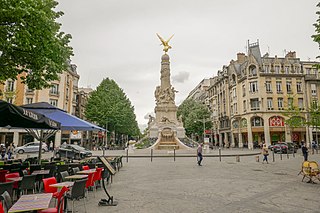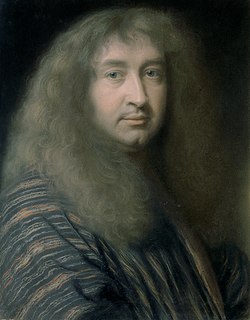
Reims is the most populous city in the French department of Marne, and the 12th most populous city in France. The city lies 129 km (80 mi) northeast of Paris on the Vesle river, a tributary of the Aisne.

Philippe-Paul, comte de Ségur was a French general and a historian.
Flodoard of Reims was a Frankish chronicler and priest of the cathedral church of Reims in the West Frankish kingdom during the decades following the dissolution of the Carolingian Empire. His historical writings are major sources for the history of Western Europe, especially France, in the early and mid-tenth century.

Robert Nanteuil was a French portrait artist: engraver, draughtsman and pastellist to the court of Louis XIV.

Jean-Baptiste Santerre was a French painter and draughtsman of the Style Louis XIV, known for his history paintings, portraits, and portrait-like genre subjects. Considerably influenced by Italian masters of the Bolognese school as well as his French contemporaries, Santerre nonetheless made an original contribution in his art, being among the first French painters to bring Netherlandish influences.
Georges Lallemand was a French artist. His name is sometimes given as "Lallemant".
Lallemant is a French surname that may originate in the phrase "l’Allemand", meaning "the German." Variants of the name include: Laleman, Lalemand, Lalemant, Lalleman, L'allemand, and Lallemand. It may refer to:

Jean-Philippe Henri Collard is a French pianist known for his interpretations of the works of Gabriel Fauré and Camille Saint-Saëns.
Jacques-Philippe Lallemant was a French Jesuit, of whom little is known beyond his writings. He took part in the discussion on the Chinese rites, and wrote the “Journal historique des assemblées tenues en Sorbonne pour condamner les Mémoires de la Chine”, a defense of his confrère Lecomte against the Sorbonnist, Jacques Lefèvre.

Charles Lallemant, was a French Jesuit. He was born in Paris in 1587 and later became the first Superior of the Jesuit Missions amongst the Huron in Canada. His letter to his brother, dated 1 August 1626, inaugurated the series Relations des Jésuites de la Nouvelle-France about the missionary work in the North American colonies of New France.
Louis Lallemant was a French Jesuit.
Events from the year 1716 in art.
Events from the year 1636 in art.
Jacques Le Fèvre was a French Roman Catholic theologian and controversialist.

Jean Philippe, bâtard d'Orléans, called le chevalier d'Orléans or le Grand Prieur d'Orléans, was an illegitimate son of Philippe d'Orléans, nephew and son-in-law of Louis XIV.
Jean-Baptiste Lallemand (1716–1803) was a French artist born in Dijon. He was mainly a painter and draftsman of landscapes and genre works. He sometimes signed himself Lallemant or Allemanus. After a stay in Italy, he went to Paris and became a member of the Académie de Saint-Luc. He died in Paris.

Colonel Raymond A. "Cheval" Lallemant, was a Belgian military pilot and flying ace who served in the British Royal Air Force (RAF) during the Second World War. He was credited with destroying six aircraft, making him one of the highest scoring Belgian aces of the conflict. Lallemant, who was nicknamed "Cheval", flew Hawker Typhoons in No. 609 Squadron in a ground attack role. Promoted to squadron leader and commanding officer of No. 609 Squadron in late 1944, Lallemand was shot down over the Netherlands in September 1944 but survived despite his injuries. He was awarded the Distinguished Flying Cross (DFC) and Bar.

Portrait of Louis XIV in Coronation Robes was painted in 1701 by the French painter Hyacinthe Rigaud after being commissioned by the king who wanted to satisfy the desire of his grandson, Philip V, for a portrait of him. Louis XIV kept it hanging at Versailles. This portrait has become the "official portrait" of Louis XIV.

After the French lifted the siege of Orléans and won a decisive victory at the Battle of Patay, the English and Burgundians no longer posed a threat. Joan of Arc convinced the Dauphin Charles to go to Reims for his coronation. Successfully marching their army though the heart of territory held by the hostile Burgundians solidified the Dauphin’s grasp on the throne of France. He had been disinherited from it through the Treaty of Troyes.

Gérard Rondeau was a French photographer. He took photographs of World War I battlefields in his native Marne, the Reims cathedral, and black-and-white portraits of celebrities and authors. His photography was exhibited both in France and internationally. He was the recipient of an award for his work. He was the illustrator of over 20 non-fiction books.
This page is based on this
Wikipedia article Text is available under the
CC BY-SA 4.0 license; additional terms may apply.
Images, videos and audio are available under their respective licenses.











